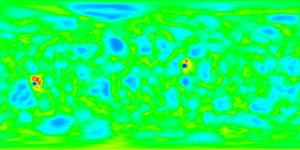Moho
Moho is the innermost planet of the Kerbol star system. It is the smallest planet, although it is not the smallest celestial body. It is the only planet known to be tidally locked to Kerbol and along with Dres, is one of the only planets with no natural satellites. As of version .18, Moho is now farther out, is no longer tidally locked, and is far easier to land on.
Contents
Topography
As of 0.18 Moho surface ranges from light brown highlands to dark brown Maria. the surface is heavily cratered; contrary to the previous version there are no longer large volcanoes on Moho and it now looks much more like a Mercury analogue.
Atmosphere
As of update 0.18 Moho has lost its atmosphere, making it much easier to reach the planet.
Orbital Statistics
Geosynchronous orbit around Moho is not possible — it would require an altitude of 0.00 m, outside of Moho's sphere of influence.
For a semi synchronous orbit of ½ Moho day (307.75 hours or 1,107,882 seconds) an orbit of 0.00 m above Moho is needed with a velocity of 0.00 m/s.
Geographical Features
Moho has a fairly heavily cratered surface, but it is less then that of the moons of Kerbin and Jool, showing signs of erosion. Because of the lack of an atmosphere on Moho, the primary suspect of Moho's erosion is volcanism. It is probable that Moho under goes volcanic periods, induced by tidal friction with Kerbol. This would lead to the filling up of craters.
Moho has two very deep wells at the geographic north and south pole of a, as yet, undetermined depth. Current analysis and probes dropped into the crater at the north pole have revealed it to be more then 5km deep, before the probe crashed into the ever narrowing canyon walls. It is possible that these are volcanic tubes that are as of this moment dormant. Further analysis of the canyon wells is needed before a definitive answer can be presented.
Reference Frames
Rotational/Inertial transition: ? m
| Warp | Minimum Altitude |
|---|---|
| 5x | 10 km |
| 10x | 10 km |
| 50x | 30 km |
| 100x | 50 km |
| 1,000x | 100 km |
| 10,000x | 200 km |
| 100,000x | 300 km |
Gallery
Changes
- Entirely changed more cratered surface.
- Color changed from red to brown.
- No more superheated atmosphere.
- Initial Release
Notes

